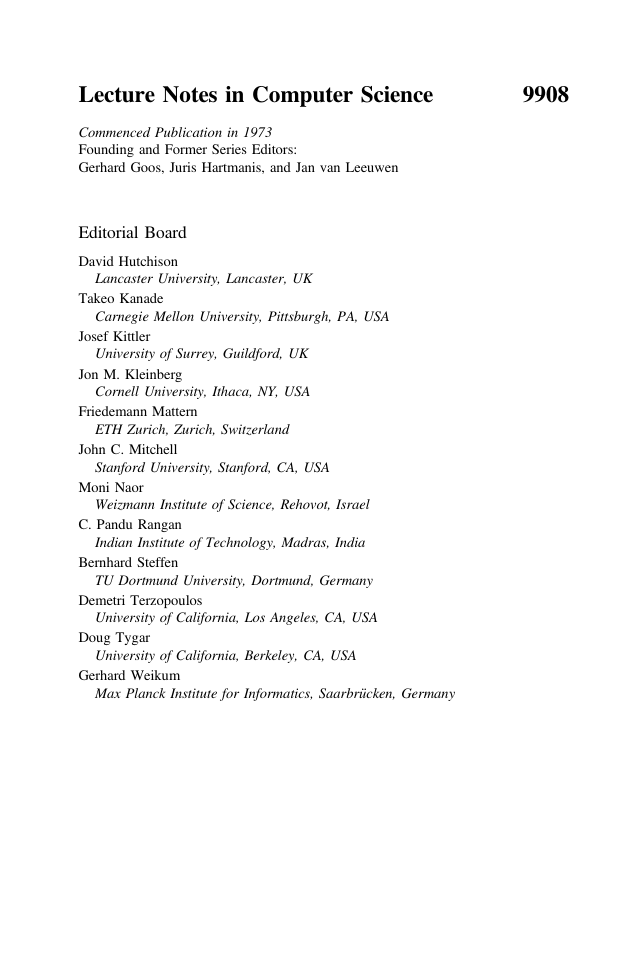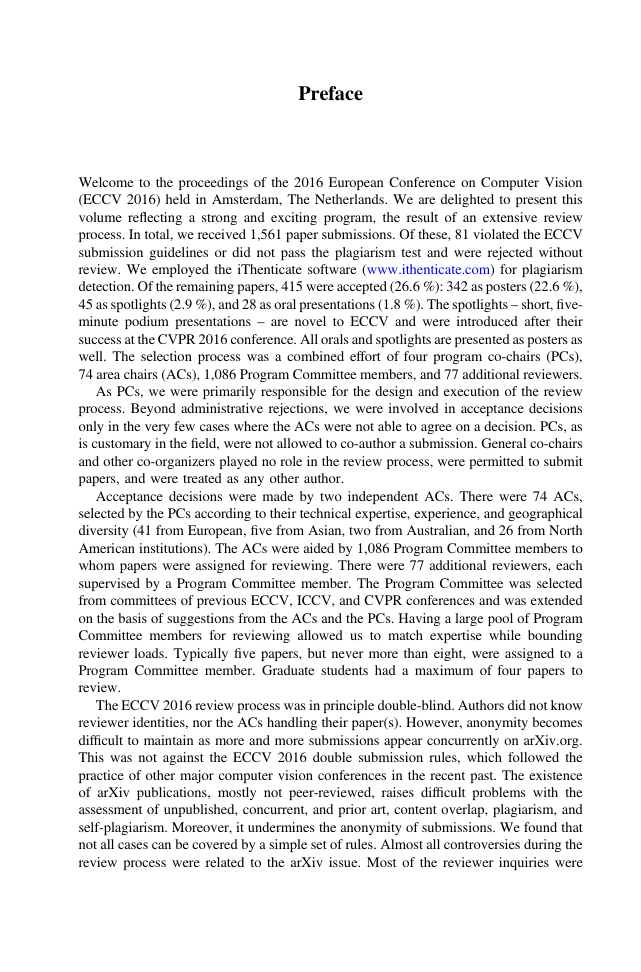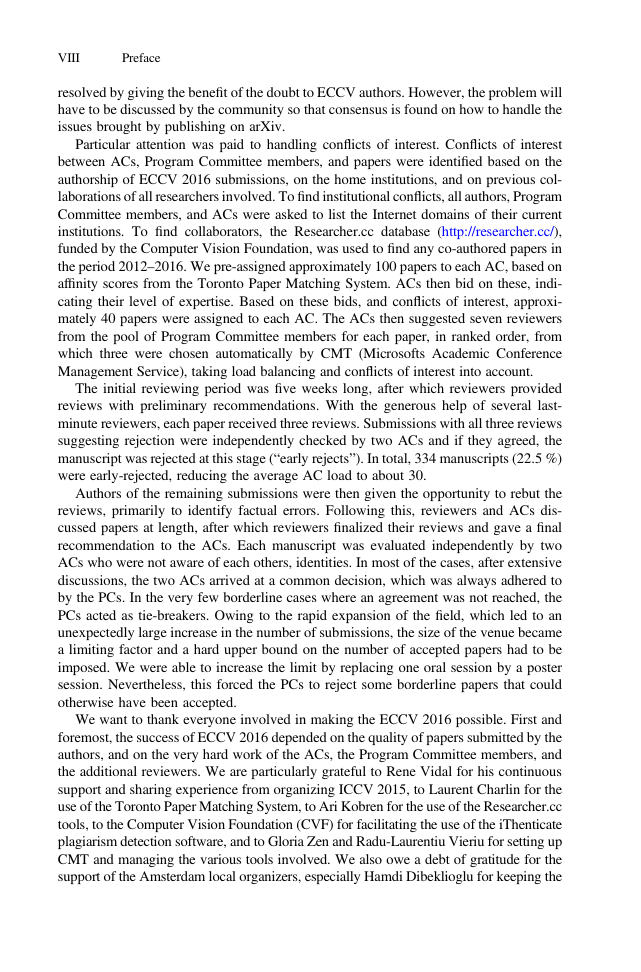Foreword
Preface
Organization
Contents -- Part IV
Poster Session 4 (Continued)
Generating Visual Explanations
1 Introduction
2 Related Work
3 Visual Explanation Model
3.1 Relevance Loss
3.2 Discriminative Loss
4 Experimental Setup
5 Results
5.1 Quantitative Results
5.2 Qualitative Results
6 Conclusion
References
Marker-Less 3D Human Motion Capture with Monocular Image Sequence and Height-Maps
1 Introduction
2 Literature Review
3 Proposed Method
3.1 Overview
3.2 Height-Map Generation
3.3 2D Joints Localization
3.4 3D Motion Estimation
4 Experiments
4.1 Datasets
4.2 Evaluation of 2D Joints Localization
4.3 Evaluation of 3D Motion Recovery with Ground-Truth 2D Joints
4.4 Evaluation of 3D Motion Recovery with Predicted 2D Joints
5 Conclusion
References
Tensor Representations via Kernel Linearization for Action Recognition from 3D Skeletons
1 Introduction
2 Related Work
3 Preliminaries
3.1 Tensor Notations
3.2 Kernel Linearization
4 Proposed Approach
4.1 Problem Formulation
4.2 Sequence Compatibility Kernel
4.3 Dynamics Compatibility Kernel
5 Computational Complexity
6 Experiments
6.1 Datasets
6.2 Experimental Setup
7 Conclusions
References
Manhattan-World Urban Reconstruction from Point Clouds
1 Introduction
2 Related Work
3 Overview
4 Candidate Box Generation
4.1 Plane Extraction
4.2 Candidate Boxes
5 Box Selection
5.1 Objectives
5.2 Optimization
6 Results and Discussion
7 Conclusions
References
From Multiview Image Curves to 3D Drawings
1 Introduction
2 Enhanced 3D Curve Sketch
3 From 3D Curve Sketch to 3D Drawing
4 Experiments and Evaluation
5 Conclusion
References
Shape from Selfies: Human Body Shape Estimation Using CCA Regression Forests
1 Introduction
2 Related Work
3 Shape Estimation Algorithm
3.1 Method Overview
3.2 Shape as a Geometric Model
3.3 Feature Extraction
3.4 View Direction Classification
3.5 Learning Shape Parameters
4 Validation and Results
5 Discussion and Conclusions
References
Can We Jointly Register and Reconstruct Creased Surfaces by Shape-from-Template Accurately?
1 Introduction
2 Background
2.1 Deformation Models and Priors in SfT
2.2 Data Constraints in SfT
2.3 Modelling Creases in Other Problem Domains and Previous Attempts in SfT
2.4 Contributions
3 Problem Formulation
3.1 Template Definition
3.2 Global Cost Function
4 Optimization
4.1 Overview
4.2 Improving Convergence
5 Experimental Results
5.1 Ground Truth Acquisition
5.2 Implementation Details and Evaluation Metrics
5.3 Results
6 Conclusion
References
Distractor-Supported Single Target Tracking in Extremely Cluttered Scenes
1 Introduction
2 Related Work
3 Proposed Distractor-Supported Single-Target Tracking Method
3.1 Robust Estimation with Coarse-to-fine Multi-level Clustering
3.2 Global Dynamic Constraint in a Feedback Loop
4 Experimental Results
4.1 Experiment on Highly Cluttered Dataset
4.2 Experiment on Non-cluttered Dataset
5 Conclusions
References
Connectionist Temporal Modeling for Weakly Supervised Action Labeling
1 Introduction
2 Related Work
3 Ordering Constrained Video Action Labeling
3.1 Extended Connectionist Temporal Classification
3.2 ECTC Forward-Backward Algorithm
4 Extension to Frame-Level Semi-supervised Learning
5 Experiments
5.1 Implementation Details
5.2 Evaluating Complex Activity Segmentation
5.3 Evaluating Action Detection
6 Conclusions
References
Deep Joint Image Filtering
1 Introduction
2 Related Work
3 Learning Deep Joint Image Filters
3.1 Network Architecture Design
3.2 Relationship to Prior Work
4 Experimental Results
4.1 Depth Map Upsampling
4.2 Joint Image Upsampling
4.3 Structure-Texture Separation
4.4 Cross-Modality Filtering for Noise Reduction
5 Discussions
6 Conclusions
References
Efficient Multi-frequency Phase Unwrapping Using Kernel Density Estimation
1 Introduction
1.1 Related Work
1.2 Structure
2 Depth Decoding
2.1 Phase Unwrapping
2.2 CRT Based Unwrapping
2.3 Phase Fusion
3 Kernel Density Based Unwrapping
3.1 Unwrapping Likelihood
3.2 Multiple Hypotheses
3.3 Phase Likelihood
3.4 Hypothesis Selection
3.5 Spatial Selection Versus Smoothing
4 Experiments
4.1 Implementation
4.2 Ground Truth for Unwrapping
4.3 Datasets
4.4 Comparison of Noise Propagation Models
4.5 Outlier Rejection
4.6 Parameter Settings
4.7 Coverage Experiments
4.8 Kinect Fusion
5 Concluding Remarks
References
A Multi-scale CNN for Affordance Segmentation in RGB Images
1 Introduction
2 Prior Work
3 Generation of Affordance Ground Truth
4 Affordance Segmentation with a Multi-scale CNN
5 Training
6 Results
7 Conclusion
References
Hierarchical Dynamic Parsing and Encoding for Action Recognition
1 Introduction
2 Related Work
3 Hierarchical Dynamic Parsing and Encoding
3.1 Unsupervised Temporal Clustering
3.2 The First Layer Modeling
3.3 The Second Layer Modeling
4 Experiments
4.1 Datasets
4.2 Experimental Setup
4.3 Influence of Parameters
4.4 Comparison of Pooling in the First Layer
4.5 Comparison with State-of-the-Art
5 Conclusions
References
Distinct Class-Specific Saliency Maps for Weakly Supervised Semantic Segmentation
1 Introduction
2 Related Work
2.1 CNN-Based Fully-Supervised Semantic Segmentation
2.2 CNN-Based Weakly-Supervised Segmentation
2.3 Gradient-Based Region Estimation with Back-Propagation
3 Methods
3.1 Overview
3.2 Training CNN
3.3 Class Saliency Maps
3.4 Fully Connected CRF
4 Experiments
4.1 Dataset
4.2 Experimental Setup
4.3 Evaluation on Class Saliency Maps
4.4 Effects of Parameter Choices
4.5 Comparison with Other Methods
5 Conclusions
References
A Diagram is Worth a Dozen Images
1 Introduction
2 Background
3 The Language of Diagrams
4 Syntactic Diagram Parsing
5 Semantic Interpretation
6 Dataset
7 Experiments
7.1 Generating Constituent Proposals
7.2 Generating Relationship Proposals
7.3 Syntactic Parsing: DPG Inference
7.4 Diagram Question Answering
8 Conclusion
References
Automatic Attribute Discovery with Neural Activations
1 Introduction
2 Related Work
3 Datasets and Pre-processing
3.1 Etsy Dataset
3.2 Wear Dataset
4 Attribute Discovery
4.1 Divergence of Neural Activations
4.2 Visualness
4.3 Human Perception
4.4 Experimental Results
5 Understanding Perceptual Depth
6 Saliency Detection
7 Conclusion
References
``What Happens If...'' Learning to Predict the Effect of Forces in Images
1 Introduction
2 Related Work
3 Problem Statement
4 Forces in Scenes (ForScene) Dataset
5 Model
5.1 Model Architecture
5.2 Training
5.3 Testing
6 Experiments
6.1 Dataset Details
6.2 Force Representation
6.3 Network and Optimization Parameters
6.4 Prediction of Velocity Sequences
6.5 Unseen Categories
7 Conclusion
References
View Synthesis by Appearance Flow
1 Introduction
2 Related Work
3 Approach
3.1 Learning View Synthesis via Appearance Flow
3.2 Learning to Leverage Multiple Input Views
4 Experiments
4.1 Novel View Synthesis for Objects
4.2 Novel View Synthesis for Scenes
5 Discussion
References
Top-Down Learning for Structured Labeling with Convolutional Pseudoprior
1 Introduction
2 Related Work
3 Formulations
4 Experiments
4.1 Sequential Labeling: 1-D Case
4.2 Image Semantic Labeling: 2-D Case
5 Conclusions
References
Generative Image Modeling Using Style and Structure Adversarial Networks
1 Introduction
2 Related Work
3 Background for Generative Adversarial Networks
4 Style and Structure GAN
4.1 Structure-GAN
4.2 Style-GAN
4.3 Multi-task Learning with Pixel-Wise Constraints
4.4 Joint Learning for S2-GAN
5 Experiments
5.1 Qualitative Results for Image Generation
5.2 Quantitative Results for Image Generation
5.3 Representation Learning for Recognition Tasks
6 Conclusion
References
Joint Learning of Semantic and Latent Attributes
1 Introduction
2 Related Work
3 Methodology
3.1 Formulation
3.2 Optimisation
3.3 Application to Person Re-ID
3.4 Application to User-Defined Attribute Prediction
4 Experiments
4.1 Person Re-ID
4.2 User-Defined Attribute Prediction
4.3 Zero-Shot Learning
4.4 Further Evaluations
5 Conclusions
References
A Unified Multi-scale Deep Convolutional Neural Network for Fast Object Detection
1 Introduction
2 Related Work
3 Multi-scale Object Proposal Network
3.1 Multi-scale Detection
3.2 Architecture
3.3 Sampling
3.4 Implementation Details
4 Object Detection Network
4.1 CNN Feature Map Approximation
4.2 Context Embedding
4.3 Implementation Details
5 Experimental Evaluation
5.1 Proposal Evaluation
5.2 Object Detection Evaluation
6 Conclusions
References
Deep Specialized Network for Illuminant Estimation
1 Introduction
2 Related Work
3 Illuminant Estimation by Convolutional Network
3.1 Hypothesis Network - a Branch-Level Ensemble Network
3.2 Selection Network - A Hypothesis Selection Network
3.3 Local to Global Estimation
4 Experiments
4.1 Global-Illuminant Setting
4.2 Multi-illuminant Setting
5 Conclusion
References
Weakly-Supervised Semantic Segmentation Using Motion Cues
1 Introduction
2 Related Work
3 Learning Semantic Segmentation from Video
3.1 Network Architecture
3.2 Estimating Latent Variables with Label Prediction
3.3 Fine-Tuning M-CNN
4 Results and Evaluation
4.1 Experimental Protocol
4.2 Implementation Details
4.3 Evaluation of M-CNN
4.4 Training on Weakly-Annotated Videos and Images
4.5 Co-localization
5 Summary
References
Human-in-the-Loop Person Re-identification
1 Introduction
2 Human-in-the-Loop Incremental Learning
2.1 Problem Formulation
2.2 Modelling Human Feedback as a Loss Function
2.3 Real-Time Model Update for Instant Feedback Reward
3 Metric Ensemble Learning for Automated Re-id
4 Experiments
4.1 Evaluation on Human-in-the-Loop Person Re-id
4.2 Evaluation on Automated Person Re-Id
5 Conclusions
References
Real-Time Monocular Segmentation and Pose Tracking of Multiple Objects
1 Introduction
1.1 Related Work
1.2 Motivation
1.3 Contributions
2 Method
2.1 Pixel-Wise Posterior Object Segmentation
2.2 Level-Set Pose Embedding
2.3 Iterative Pose Optimization
2.4 Initialization
3 Implementation
3.1 Rendering Engine
3.2 Image Processing
3.3 Occlusion Handling
4 Evaluation
4.1 Performance Analysis
4.2 Experimental Comparison
5 Conclusions
References
Estimation of Human Body Shape in Motion with Wide Clothing
1 Introduction
2 Related Work
3 S-SCAPE Model
4 Estimating Model Parameters for a Motion Sequence
4.1 Prior Model for
4.2 Landmark Energy
4.3 Data Energy
4.4 Clothing Energy
4.5 Optimization Schedule
5 Implementation Details
6 Evaluation
6.1 Dataset
6.2 Evaluation of Posture and Shape Fitting
6.3 Comparative Evaluation
7 Conclusion
References
A Shape-Based Approach for Salient Object Detection Using Deep Learning
1 Introduction
2 Related Work
3 Proposed Method
3.1 Saliency Representation
3.2 Convolutional Neural Networks for Shape Prediction
3.3 Refinement of Saliency Maps Using Hierarchical Segmentations
4 Experimental Results
4.1 Experimental Settings
4.2 Experimental Results
5 Conclusions
References
Fast Optical Flow Using Dense Inverse Search
1 Introduction
1.1 Related Work
1.2 Contributions
2 Proposed Method
2.1 Fast Inverse Search for Correspondences
2.2 Fast Optical Flow with Multi-scale Reasoning
2.3 Fast Variational Refinement
2.4 Extensions
3 Experiments
3.1 Implementation and Parameter Selection
3.2 Evaluation of Inverse Search
3.3 MPI Sintel Optical Flow Results
3.4 KITTI Optical Flow Results
3.5 High Frame-Rate Optical Flow
4 Conclusions
References
Global Registration of 3D Point Sets via LRS Decomposition
1 Introduction
2 Low-Rank and Sparse Decomposition
3 Problem Definition
4 Proposed Approach
5 Experiments
5.1 Simulated Data
5.2 Real Data
6 Conclusions
References
Recognition from Hand Cameras: A Revisit with Deep Learning
1 Introduction
2 Related Work
2.1 Egocentric Recognition
2.2 Hand Detection and Pose Estimation
2.3 Camera for Hands
3 Our System
3.1 Wearable Cues
3.2 Hand Alignment
3.3 Hand States Recognition
3.4 State Change Detection
3.5 Full Model
3.6 Deep Feature
3.7 Object Discovery
3.8 Combining HandCam with HeadCam
4 Dataset
5 Implementation Details
6 Experiment Results
6.1 Free Vs. Active Recognition
6.2 Gesture Recognition
6.3 Object Category Recognition
6.4 Combining HandCam with HeadCam
7 Conclusion
References
Learning
XNOR-Net: ImageNet Classification Using Binary Convolutional Neural Networks
1 Introduction
2 Related Work
3 Binary Convolutional Neural Network
3.1 Binary-Weight-Networks
3.2 XNOR-Networks
4 Experiments
4.1 Efficiency Analysis
4.2 Image Classification
4.3 Ablation Studies
5 Conclusion
References
Top-Down Neural Attention by Excitation Backprop
1 Introduction
2 Related Work
3 Method
3.1 Top-Down Neural Attention Based on Probabilistic WTA
3.2 Excitation Backprop
3.3 Contrastive Top-Down Attention
4 Experiments
4.1 The Pointing Game
4.2 Localizing Dominant Objects
4.3 Text-to-Region Association
5 Conclusion
References
Learning Recursive Filters for Low-Level Vision via a Hybrid Neural Network
1 Introduction
2 Related Work
3 Recursive Filter via RNNs
3.1 Preliminaries of Recursive Filters
3.2 Recursive Decomposition
3.3 Constructing Recursive Filter via Linear RNNs
4 Learning Spatially Variant Recursive Filters
4.1 Spatially Variant LRNN
4.2 Learning LRNN Weight Maps via CNN
5 Experimental Results
5.1 Edge-Preserving Smoothing
5.2 Image Denoising
5.3 Image Propagation Examples
6 Conclusion
References
Learning Representations for Automatic Colorization
1 Introduction
2 Related Work
3 Method
3.1 Color Spaces
3.2 Loss
3.3 Inference
3.4 Histogram Transfer from Ground-Truth
3.5 Neural Network Architecture and Training
4 Experiments
4.1 Representation Learning
5 Conclusion
References
Poster Session 5
Deep Reconstruction-Classification Networks for Unsupervised Domain Adaptation
1 Introduction
2 Related Work
3 Deep Reconstruction-Classification Networks
4 Experiments and Results
4.1 Experiment I: SVHN, MNIST, USPS, CIFAR, and STL
4.2 Experiments II: Office Dataset
5 Analysis
6 Conclusions
References
Learning Without Forgetting
1 Introduction
2 Related Work
3 Learning Without Forgetting
4 Experiments
4.1 Main Experiments
4.2 Design Choices and Alternatives
5 Discussion
References
Identity Mappings in Deep Residual Networks
1 Introduction
2 Analysis of Deep Residual Networks
3 On the Importance of Identity Skip Connections
3.1 Experiments on Skip Connections
3.2 Discussions
4 On the Usage of Activation Functions
4.1 Experiments on Activation
4.2 Analysis
5 Results
6 Conclusions
References
Deep Networks with Stochastic Depth
1 Introduction
2 Background
3 Deep Networks with Stochastic Depth
4 Results
5 Analytic Experiments
6 Conclusion
References
Less Is More: Towards Compact CNNs
1 Introduction
2 Related Work
3 Sparse Constrained Convolutional Neural Networks
3.1 Training a Sparse Constrained CNN
3.2 Forward-Backward Splitting
4 Sparse Constraints
4.1 Tensor Low Rank Constraints
4.2 Group Sparse Constraints
5 Importance of Rectified Linear Units in Sparse Constrained CNNs
6 Experiments
6.1 LeNet on MNIST
6.2 CIFAR-10 Quick on CIFAR-10
6.3 AlexNet and VGG on ImageNet
7 Conclusion
References
Unsupervised Visual Representation Learning by Graph-Based Consistent Constraints
1 Introduction
2 Related Work
3 Overview
4 Unsupervised Constraint Mining
4.1 Positive Constraint Mining
4.2 Negative Constraint Mining
5 Visual Representation Learning
5.1 Unsupervised Feature Learning
5.2 Semi-supervised Learning
6 Experiments
6.1 Implementation Details
6.2 Datasets and Evaluation Metrics
6.3 Controlled Experiments
6.4 Unsupervised Learning Results
6.5 Semi-supervised Learning Results
7 Conclusions
References
Seed, Expand and Constrain: Three Principles for Weakly-Supervised Image Segmentation
1 Introduction
2 Related Work
3 Weakly Supervised Segmentation from Image-Level Labels
3.1 The SEC Loss for Weakly Supervised Image Segmentation
3.2 Training
4 Experiments
4.1 Experimental Setup
4.2 Results
4.3 Detailed Discussion
5 Conclusion
References
Patch-Based Low-Rank Matrix Completion for Learning of Shape and Motion Models from Few Training Samples
1 Introduction
1.1 Related Work
2 Methods
2.1 Low-Rank Matrix Completion of Ill-Conditioned matrices
2.2 Patch-Based Model Generation
2.3 Patch Selection and Domain Partitioning
3 Experiments and Applications
3.1 2D Contour Data of the IMM Face Database
3.2 3D Lung Surfaces of the LIDC Database
3.3 Respiratory Lung Motion
4 Results
5 Discussion and Conclusion
References
Chained Predictions Using Convolutional Neural Networks
1 Introduction
2 Related Work
3 Chain Models for Structured Tasks
3.1 Chain Models for Single Images
3.2 Chain Models for Videos
3.3 Improved Learning with Scheduled Sampling
4 Experimental Evaluation
4.1 Pose Estimation from a Single Image
4.2 Pose Estimation from Videos
5 Conclusions
References
Multi-region Two-Stream R-CNN for Action Detection
1 Introduction
2 Related Work
3 End-to-end Two-Stream Faster R-CNN
4 Multi-region Two-Stream Faster R-CNN
5 Linking and Temporal Localization
6 Experiments
6.1 Datasets and Evaluation Metrics
6.2 Implementation Details
6.3 Evaluation of Multi-region Two-Stream Faster R-CNN
6.4 Comparison to the State of the Art
7 Conclusion
References
Semantic Co-segmentation in Videos
1 Introduction
2 Related Work
3 Proposed Algorithm
3.1 Overview
3.2 Semantic Tracklet Generation
3.3 Semantic Tracklet Co-selection via Submodular Function
4 Experimental Results
4.1 Experimental Settings
4.2 Youtube-Objects Dataset
4.3 MOViCS Dataset
4.4 Safari Dataset
5 Concluding Remarks
References
Attribute2Image: Conditional Image Generation from Visual Attributes
1 Introduction
2 Related Work
3 Attribute-Conditioned Generative Modeling of Images
3.1 Base Model: Conditional Variational Auto-Encoder (CVAE)
3.2 Disentangling CVAE with a Layered Representation
4 Posterior Inference via Optimization
5 Experiments
5.1 Attribute-Conditioned Image Generation
5.2 Attribute-Conditioned Image Reconstruction and Completion
6 Conclusion
References
Modeling Context Between Objects for Referring Expression Understanding
1 Introduction
2 Related Work
3 Modeling Context Between Objects
4 Experiments
4.1 Datasets
4.2 Implementation Details
4.3 Comparison of Different Techniques
4.4 Ablation Experiments
5 Conclusions
References
Friction from Reflectance: Deep Reflectance Codes for Predicting Physical Surface Properties from One-Shot In-Field Reflectance
1 Introduction
2 Related Work
3 One-Shot In-Field Reflectance Disks
4 Deep Reflectance Codes
5 Friction from Reflectance
5.1 Friction-Reflectance Database
5.2 Hashing for Friction Prediction
6 Experimental Results
6.1 Hashing for Material Recognition
6.2 Friction Prediction
7 Conclusions
References
Saliency Detection with Recurrent Fully Convolutional Networks
1 Introduction
2 Related Work
3 Saliency Prediction by Recurrent Networks
3.1 Fully Convolutional Networks for Saliency Detection
3.2 Recurrent Network for Saliency Detection
3.3 Training RFCN for Saliency Detection
3.4 Post-processing
4 Experiments
4.1 Experimental Setup
4.2 Performance Comparison with State-of-the-art
4.3 Ablation Studies
5 Conclusions
References
Deep3D: Fully Automatic 2D-to-3D Video Conversion with Deep Convolutional Neural Networks
1 Introduction
2 Related Work
3 Method
3.1 Model Architecture
3.2 Reconstruction with Selection Layer
3.3 Scaling up to Full Resolution
4 Dataset
5 Experiments
5.1 Implementation Details
5.2 Comparison Algorithms
5.3 Results
5.4 Algorithm Analysis
6 Conclusions
References
Temporal Model Adaptation for Person Re-identification
1 Introduction
2 Relation to Existing Work
3 Temporal Model Adaptation for Re-identification
3.1 Preliminaries
3.2 Low-Rank Sparse Similarity-Dissimilarity Learning
3.3 Model Adaptation with Reduced Human Effort
3.4 Discussion
4 Experimental Results
4.1 State-of-the-art Comparisons
4.2 Influence of the Temporal Model Adaptation Components
4.3 Computational Complexity
5 Conclusion
References
Author Index
















 2023年江西萍乡中考道德与法治真题及答案.doc
2023年江西萍乡中考道德与法治真题及答案.doc 2012年重庆南川中考生物真题及答案.doc
2012年重庆南川中考生物真题及答案.doc 2013年江西师范大学地理学综合及文艺理论基础考研真题.doc
2013年江西师范大学地理学综合及文艺理论基础考研真题.doc 2020年四川甘孜小升初语文真题及答案I卷.doc
2020年四川甘孜小升初语文真题及答案I卷.doc 2020年注册岩土工程师专业基础考试真题及答案.doc
2020年注册岩土工程师专业基础考试真题及答案.doc 2023-2024学年福建省厦门市九年级上学期数学月考试题及答案.doc
2023-2024学年福建省厦门市九年级上学期数学月考试题及答案.doc 2021-2022学年辽宁省沈阳市大东区九年级上学期语文期末试题及答案.doc
2021-2022学年辽宁省沈阳市大东区九年级上学期语文期末试题及答案.doc 2022-2023学年北京东城区初三第一学期物理期末试卷及答案.doc
2022-2023学年北京东城区初三第一学期物理期末试卷及答案.doc 2018上半年江西教师资格初中地理学科知识与教学能力真题及答案.doc
2018上半年江西教师资格初中地理学科知识与教学能力真题及答案.doc 2012年河北国家公务员申论考试真题及答案-省级.doc
2012年河北国家公务员申论考试真题及答案-省级.doc 2020-2021学年江苏省扬州市江都区邵樊片九年级上学期数学第一次质量检测试题及答案.doc
2020-2021学年江苏省扬州市江都区邵樊片九年级上学期数学第一次质量检测试题及答案.doc 2022下半年黑龙江教师资格证中学综合素质真题及答案.doc
2022下半年黑龙江教师资格证中学综合素质真题及答案.doc